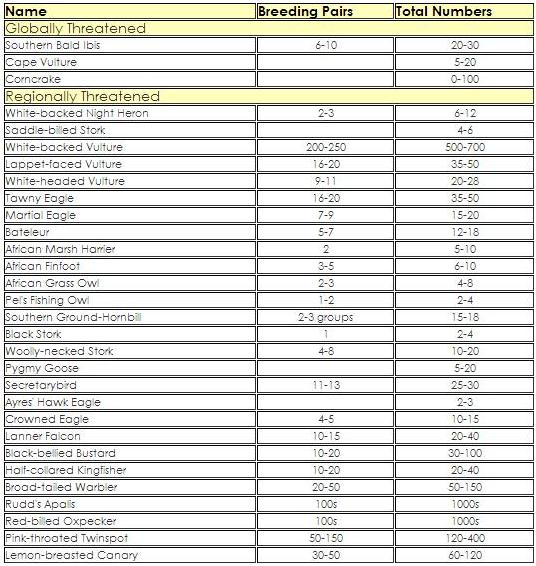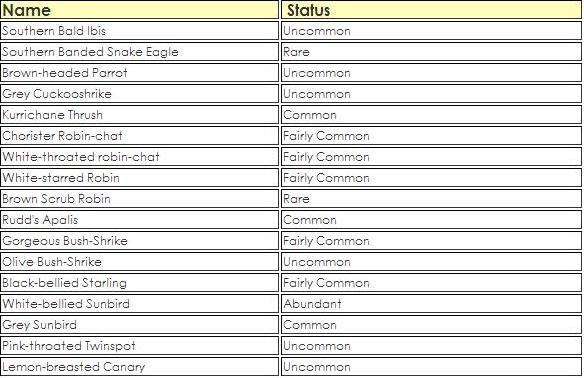IBA Hluhluwe-Umfolozi Park
SA Number: SA 060
Status: Global IBA (A1, A2, A3)
Site Description
The Hluhluwe–Umfolozi Park (HUP) lies 20 km northwest of Mtubatuba, at the junction of the coastal plain and the foothills of the KwaZulu-Natal interior. The landscape is undulating to hilly. There is a gradual drop in altitude – from 580 to 90 m a.s.l. – from west to east along the Natal Monocline. The Hluhluwe River and its tributary, the Nzimane, dissect the northern portion of the Park. A dam outside the Park boundary has pushed an artificial lake back along the lower reaches of the Hluhluwe River. In the south the Black Umfolozi and White Umfolozi rivers meander widely, before uniting at the south-eastern corner of the Park. All these rivers flow permanently. There are many other seasonal streams and ephemeral rivers. Soils on higher ground are stony and shallow, being largely derived from Ecca and Beaufort Sandstones. Soils lower down are often deep and fertile; some are derived from lava flows. Alongside the Black and White Umfolozi rivers are recent alluvial deposits. HUP has a subtropical climate. The temperature ranges from an average minimum of 13°C to an average maximum of 33°C; temperature rarely falls to zero, and frost is rare. Rainfall varies from 600 mm p.a. in the south of Umfolozi, to 1 250 mm p.a. at Hilltop in Hluhluwe. Most rain falls in summer (October–March), winters are mild and dry.
The Park's vegetation is classified as Lowveld and Zululand Thornveld. Accounts from the early 1800s describe grassland with very few trees. Another from 1921 described Hluhluwe as mainly thornveld. Bushveld encroachment accelerated owing to the decimation of the large game that drove the regeneration of the open grassveld. Today the bushing-up process and spread of closed canopy forest is fairly rapid. Grassland composition varies with altitude and soil. Transition of grassland to parkland can be seen in the corridor, while well-developed woodlands occur over much of the reserve with the spread of thickets also occurring. Grasslands and woodlands are regularly burnt, in principle in a mosaic pattern. Closed evergreen forest occurs in the higher-rainfall areas of the north. Riverine forest used to line large stretches of the major rivers until Cyclone Demoina swept nearly all away in 1984. Regeneration has been slow, and this habitat will not be restored to its former glory for some years.
Birds
The Park is known to support over 400 bird species, about 46% of the species found in the southern African sub-region. The bird diversity within the Park can be attributed to the variety of habitats in this area. This diversity includes a number of important populations of larger, widespread birds that have suffered outside large protected areas. The riverine thickets constitute forest corridors that are used by some altitudinal migrant forest species of the Drakensberg escarpment to the west. These birds move down to the lowveld to escape the severe escarpment winters. Large riverine trees also provide habitat for many of the more secretive river-dependent species such as the White-backed Night Heron and African Finfoot. The taller riverine trees provide nesting sites for other species, particularly raptors such as the Bat Hawk.
The rivers, floodplains, pans, dams and vleis are important for many wetland-dependent and associated birds including the Black Stork, which breed in gorges in the nearby mountains. Woolly-necked Stork, African Open-billed and Saddle-billed Stork occur in small numbers. When conditions are suitable, the following wetland species occur in small numbers; Pink-backed Pelican, Great White Pelican, Lesser Moorhen, Allen's Gallinule and African Marsh Harrier. Several pairs of Southern Bald Ibis are known to breed within the complex, but they forage mostly outside the area.
Several large species that are rare outside South Africa’s large parks are locally common here, including White-backed Vulture, Lappet-faced Vulture, White-headed Vulture, Martial Eagle, Bateleur and Tawny Eagle. Southern Ground-Hornbill, Denham’s Bustard, Pallid Harrier and African Grass Owl occur in smaller numbers. The varied woodland communities support several typical bushveld species, including Brown-headed Parrot, White-throated Robin-chat, Gorgeous Bush-Shrike and Grey Sunbird. The small patches of Lala Palm savanna support Lemon-breasted Canary.
Key Species
Threatened Species
 Range and Biome Restricted Species
Range and Biome Restricted Species





